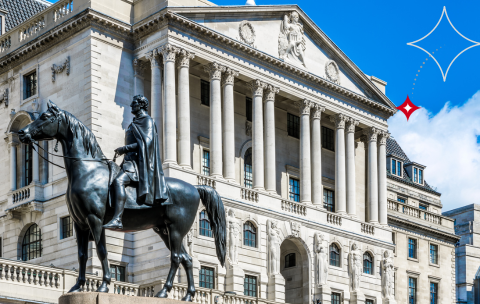Weekly Brief

No pause for celebration
10 minute read22 September 2023
GBP
The Bank of England (BoE) surprised some (but not all) with their decision to maintain UK rates at 5.25% this week. The move marked the first pause in rate hikes from the BoE after 14-straight increases and came after recent figures confirmed an unexpected faster slowdown in inflation during August, which had encouraged several analysts to change their predicted outcome to a pause for this meeting. The decision was a very close call, with five Monetary Policy Committee (MPC) members voting for a pause, against four voting for a 25bps rate hike.
During his post-meeting press conference, BoE Governor Andrew Bailey said; ‘inflation has fallen a lot in recent months, and we think it will continue to do so.’ Despite the good news for UK borrowers, Bailey warned against a ’premature celebration’, given that there is still a long way to go before inflation reaches the BoE’s longstanding target level of 2%.
Furthermore, with the recent rises in energy prices expected to increase headline inflation over the coming months, a cautious welcome to the news seems sensible. Much the same as the Federal Reserve (Fed), the BoE warned that moving to a pause should not mean that the chances of any imminent rate cuts have materially increased.
The news will also be good news for the government, who have been burdened with existing debt interest payments. The government will have also welcomed confirmation on the same day that the latest government borrowing requirements came in under the OBR’s March expectations.
The pound slipped to a multi-month low on the BoE news, with GBP/USD moving under 1.2300 for the first occasion since April, and GBP/EUR slipping to a two-month low under 1.1530. GBP/USD has been under intense selling pressures of late, consistent with other major currencies against the resurgent dollar.
EUR
Last week’s decision by the European Central Bank (ECB) to raise Euro area interest rates by another 25bps has done little to halt the decline for the single currency. During that time, ECB officials have continued to highlight the prospect for further rate hikes in the region, given that inflation is not falling ‘at the desired pace.’ Markets have focused on the outlook for the region’s growth, which is likely to remain constricted, as incoming economic data signals the potential for further weakness.
Market-implied prospects for further ECB rate hikes in this environment have therefore diminished significantly, even if the ECB are still suggesting otherwise. EUR/USD yesterday (Thursday) hit a cycle low of 1.0616, a level not tested since March. The pair is now heading towards a tenth-straight week of declines, its worst weekly run since 2014. Perhaps the best chance of a reversal in EUR/USD might currently be the dollar reaching exhaustion point, after such a long and powerful rally (see USD).
Regional inflation data will be the major highlight among incoming economic data for next week. With energy prices rising sharply, headline Consumer Price Inflation (CPI) could be vulnerable to an upside surprise, when September’s preliminary figures are released. Germany release their latest inflation updates a day beforehand. Today’s (Friday) Purchasing Managers Index (PMI) updates are likely to reflect softness across the region, with the ongoing softness among manufacturing morphing into a previously-resistant service sector.
USD
As had been widely expected, the Federal Reserve (Fed) paused US rate hikes for the second meeting this year, keeping their target rate at 5.25 – 5.5% in the process. However, in their latest ‘dot plot’ interest rate and economic updates, 12 members of the Federal Open Market Committee (FOMC) still think that the Fed will need to raise US rates by another 25bps later this year, with 7 members thinking that a pause will instead persist. On the interest rate outlook, the Fed made upside revisions to the median interest rate over the next 2 years, implying that US interest rates are likely to stay higher for longer. The Fed also revised their growth targets for this year, which in essence was a mark-to-market against actual growth in the US.
In his post-meeting press conference, Fed Chair Powell went to script, highlighting that the Fed had decided to halt rate hikes in lieu of how far they have come and that a ‘soft landing’ for US economy still remains their primary objective. As ever, Powell was keen to stress that the Fed are still prepared to hike rates further if conditions dictate, whilst indicating they are close to reaching the end of their hiking cycle. He pointed out that inflation had moderated but remains ‘well above’ the Fed’s goal. Powell also highlighted the recent slowdown in the Labor market, with wage growth recently slowing. On the recent rise in energy prices, he stressed the impact to consumers, and that the Fed need to monitor those energy price increases over a longer period, but ‘look through’ energy moves as short-term volatility.
The immediate reaction from markets resulted in a swift downturn in risk sentiment, with markets focussing on the prospect for higher rates for longer. Equities struggled across the board and the yield on the two-year US Treasury rose to its highest level since 2006. Among currencies, the dollar continued its impressive late cycle strength, with the dollar index (DXY) accelerating to its highest level since April, moving clearly above 105.30. USD/JPY also rallied to as high as 148.50, with the psychologically significant 150.00 region putting markets on intervention risk. As expected, the Bank of Japan (BoJ) made no changes to Japanese interest rates, their target level for the 10-year JGB, or forward guidance at their latest policy meeting overnight.
Looking ahead, incoming US data remains key to future risk sentiment, with the latest Core Personal Consumption Expenditures (PCE) Price Index set for release next week. The Fed play particularly close attention to Core PCE. The next iteration of Q2 growth is also set for release next week.
CAD
Buoyed by surging oil prices, USD/CAD had been on a fairly consistent move over the past 10 days, slipping from just under 1.3700, to reach a monthly low of 1.3380, clearly defying the broader trend of a much stronger greenback. A sudden spike in Canadian headline inflation from 3.3% in July to 4% (also impacted by higher energy prices) has increased the possibility of another Bank of Canada (BoC) rate hike at some point later this year, which may have added to those declines in USD/CAD. However, Wednesday’s FOMC meeting (see USD) inspired an abrupt reversal in USD/CAD, resulting in strong gains for the greenback, as both the Loonie and oil prices suffered sharp losses. USD/CAD promptly rallied back over 1.3500, as oil headed lower towards $90pbl.
Whilst incoming Canadian economic data will play a significant role in the immediate future direction for USD/CAD - including next week’s Retail Sales and GDP data - oil prices and the broader direction of the greenback are considered more likely to have a bigger impact to the short-term profile for USD/CAD.
AUD & NZD
The latest growth update confirmed the New Zealand economy has expanded at a much faster pace than anticipated, with growth rising by a solid 0.9% during Q2, having been expected to have risen by 0.5% over the period. Growth also increased by 1.8% on an annual basis, slightly lower than 2.2% previously, but well ahead of the 1.2% forecast. The move was underpinned by strength among the services sector, helping to pull New Zealand’s economy away from a potential technical recession.
The news may be of a concern to the Reserve Bank of New Zealand (RBNZ), who have suggested that the economy will require lower growth to help dampen surging inflation. When you factor in recent higher energy prices, the chances of higher rates for longer in New Zealand have increased, albeit at the margin. The news has helped the Kiwi to mark a potentially higher week against an otherwise resurgent greenback, with NZD/USD rising to back over 0.5925 as of Thursday afternoon.
The latest Reserve Bank of Australia (RBA) minutes confirmed that they considered raising Australian interest rates by 25bps, before eventually settling on a pause at the current rate of 4.1%. Recent data showed inflation returned to the RBA’s target level within a ‘reasonable timeframe,’ while the cash rate remains at its present level. AUD/USD remains close to the recent low but is attempting to hold over 0.6400. Both inflation and Retail Sales data are due for release next week in Australia.
Author
Daniel Jones - Corporate FX Dealer
This commentary does not constitute financial advice


